The Response of Grain Potential Productivity to Land Use Change: A Case Study in Western Jilin, China
Abstract
:1. Introduction
2. Material and Methods
2.1. Study Area
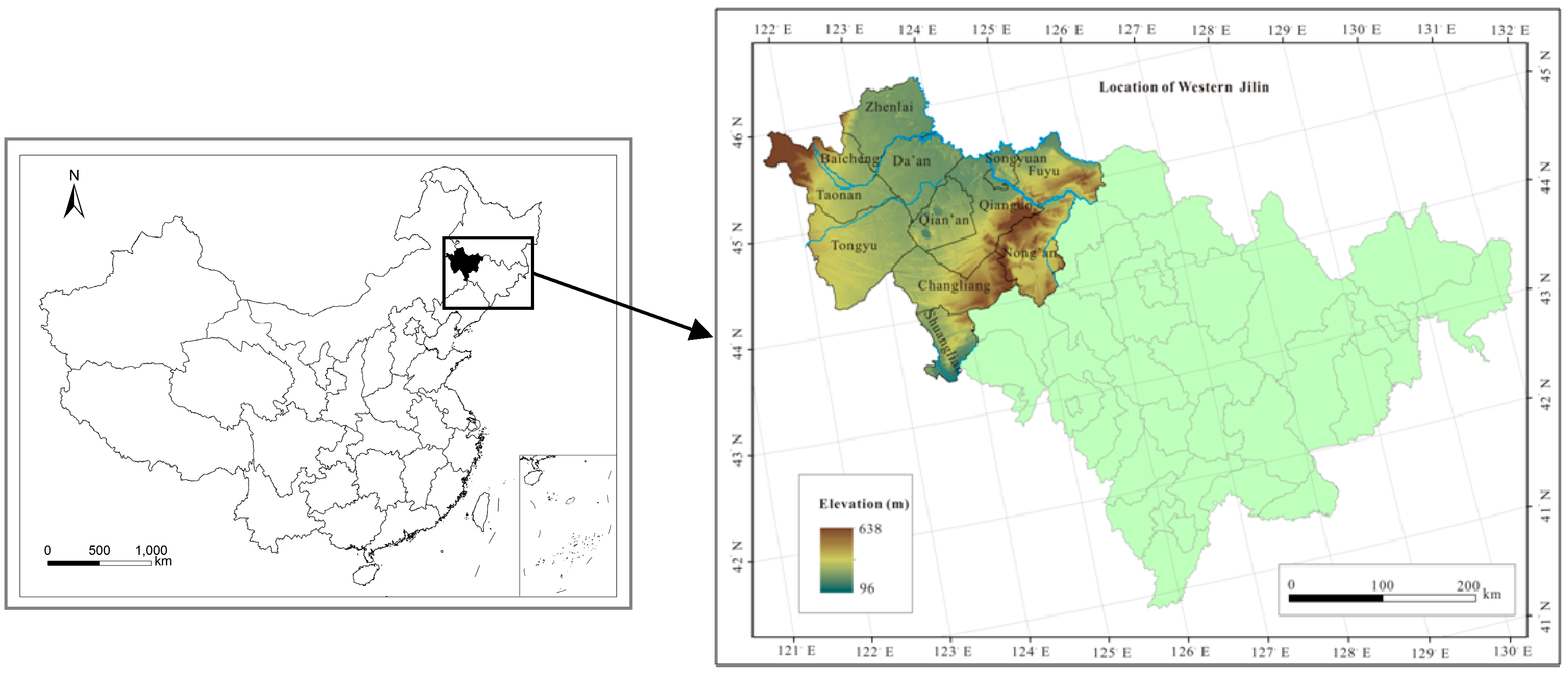
2.2. Data Source
2.3. Methodology
2.3.1. Grain Potential Productivity Estimation Method
- (i)
- Module I: Climate data analysis and compilation of general agro-climatic indicators
- (ii)
- Module II: Crop-specific agro-climatic assessment and water-limited biomass/yield calculation
- (iii)
- Module III: Yield-reduction due to agro-climatic constraints
- (iv)
- Module IV: Edaphic assessment and yield reduction due to soil and terrain limitations
- (v)
- Module V: Integration of results from Modules I–IV into crop-specific grid-cell databases.Two main activities were involved in obtaining grid-cell level area, yield and production of prevailing main crops, namely:
- (vi)
- Module VI: Estimation of shares of rain-fed or irrigated cultivated land by 5’ grid cell, and estimation of area, yield and production of the main crops in the rain-fed and irrigated cultivated land shares.
2.3.2. Land Use Change Impact Analysis on Grain Potential Productivity
3. Results and Analysis
3.1. Results Validation
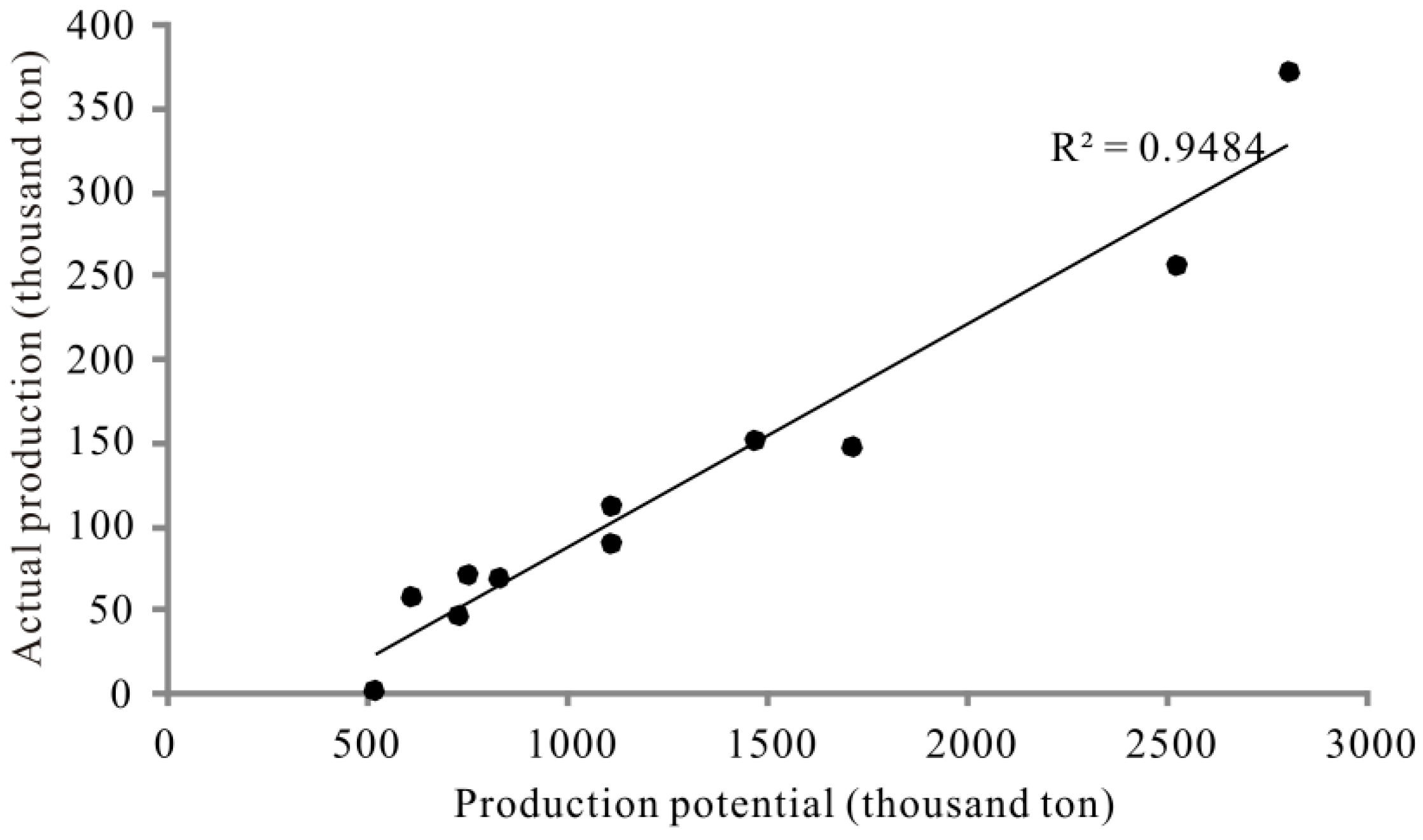
3.2. Land Use Change between 1975 and 2010
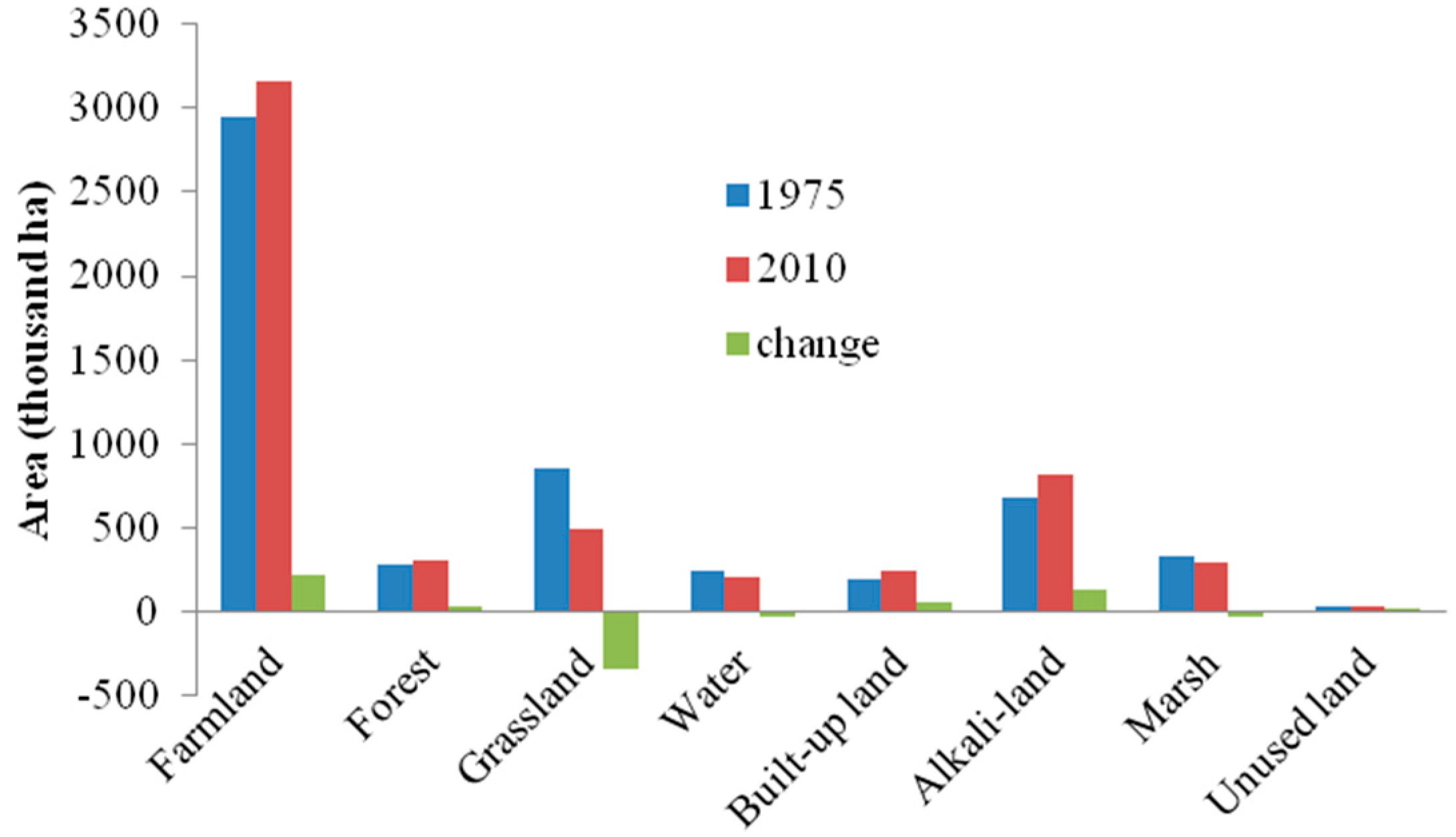
3.3. Changes in Grain Potential Productivity between 1975 and 2010
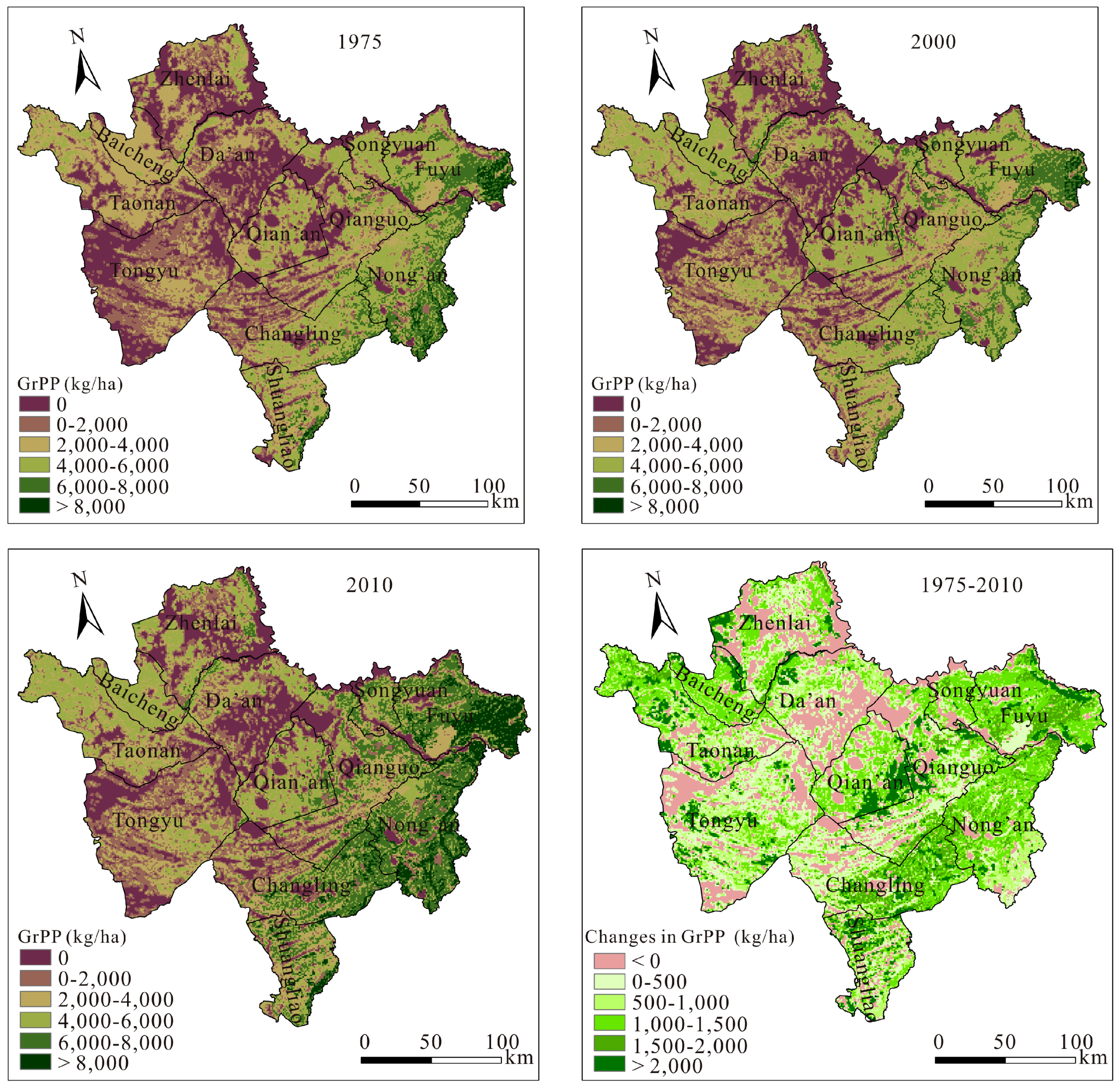
3.4. Grain Potential Productivity Changes Caused by Land Use Change
| Scenarios | GrPP in 1975 | GrPP in 2000 | GrPP in 2010 |
|---|---|---|---|
| Climate and land use both changed between 1975 and 2010 | 14.18 | 16.62 | 19.12 |
| Land use changed only between 1975 and 2010 * | 14.18 | 18.23 | 16.43 |
| Land use type converted only between 1975 and 2010 | 14.18 | 14.87 | 15.04 |
| Irrigation percentage altered only between 1975 and 2010 | 14.18 | 17.30 | 15.42 |
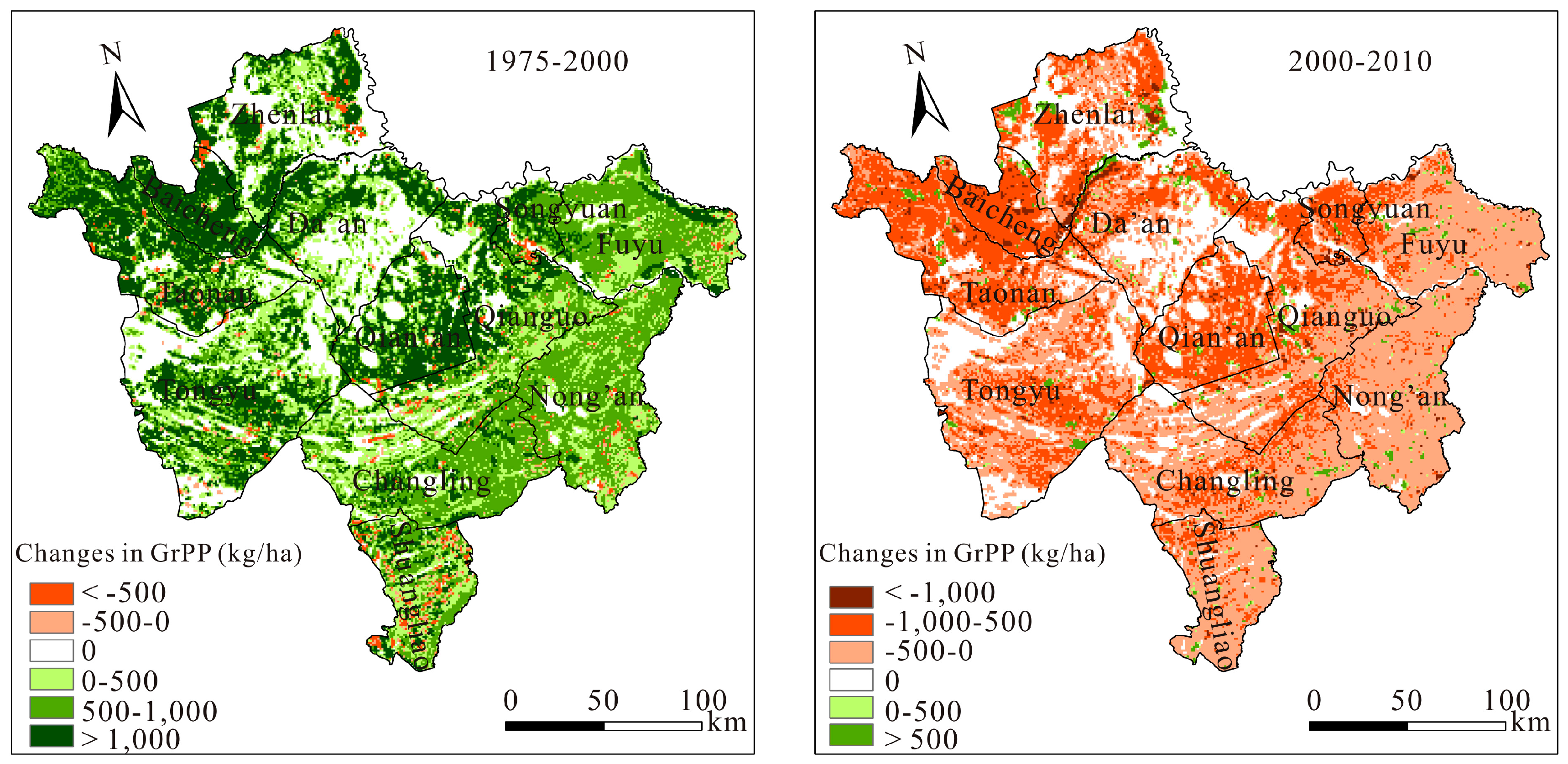
4. Discussion
4.1. Response of Grain Potential Productivity to Land Use Change between 1975 and 2000
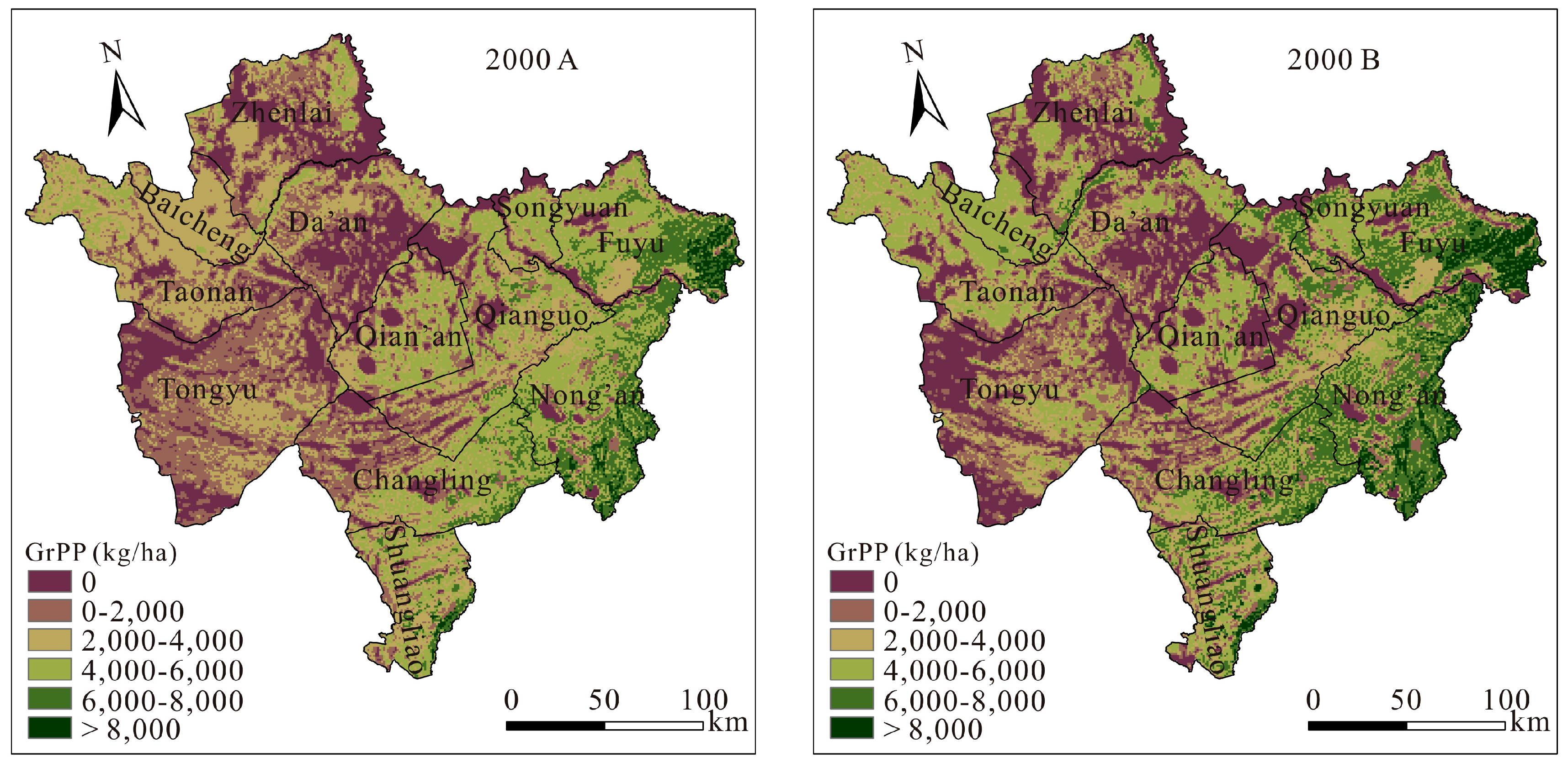
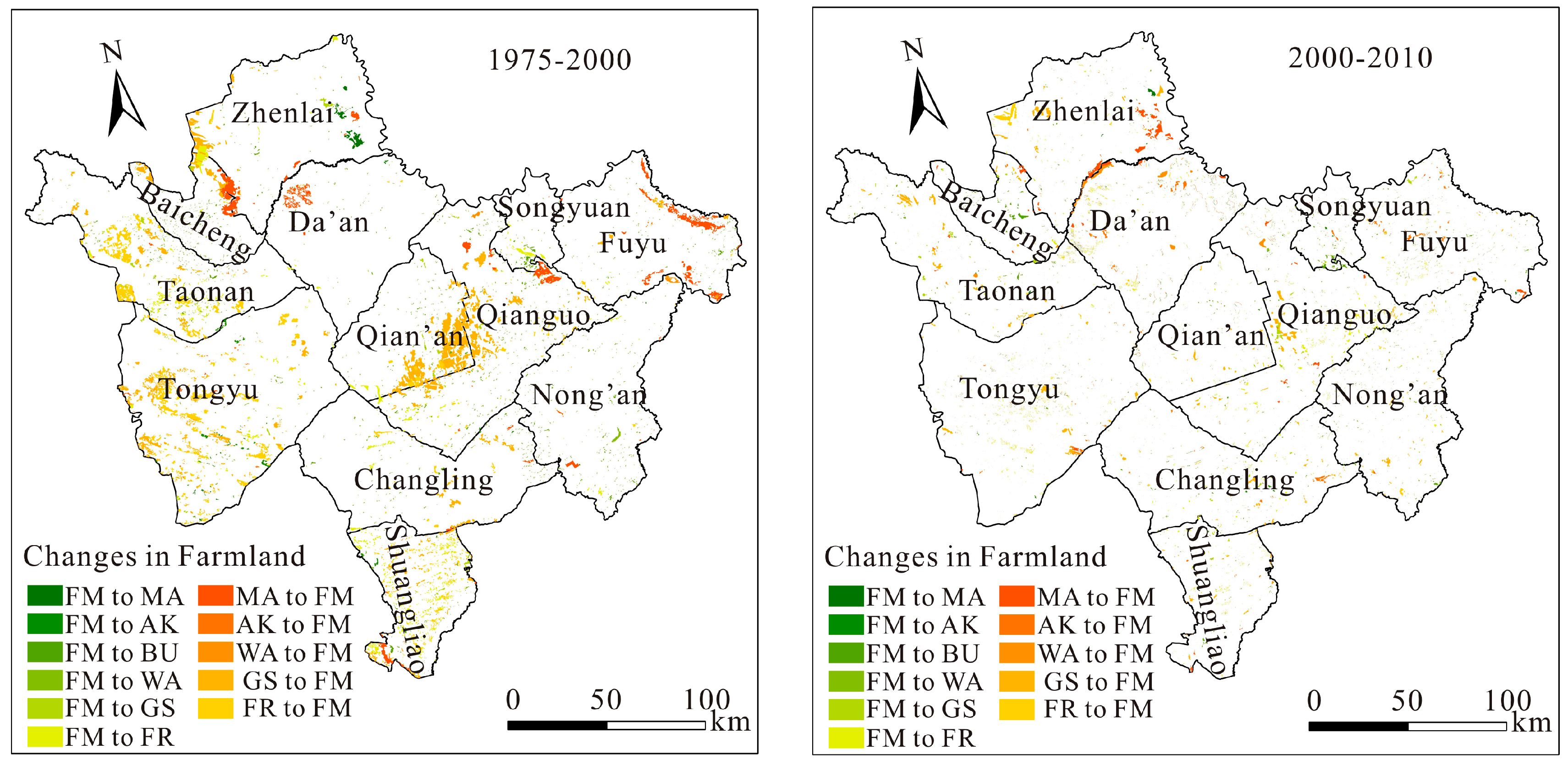
4.2. Response of Grain Potential Productivity to Land Use Change between 2000 and 2010
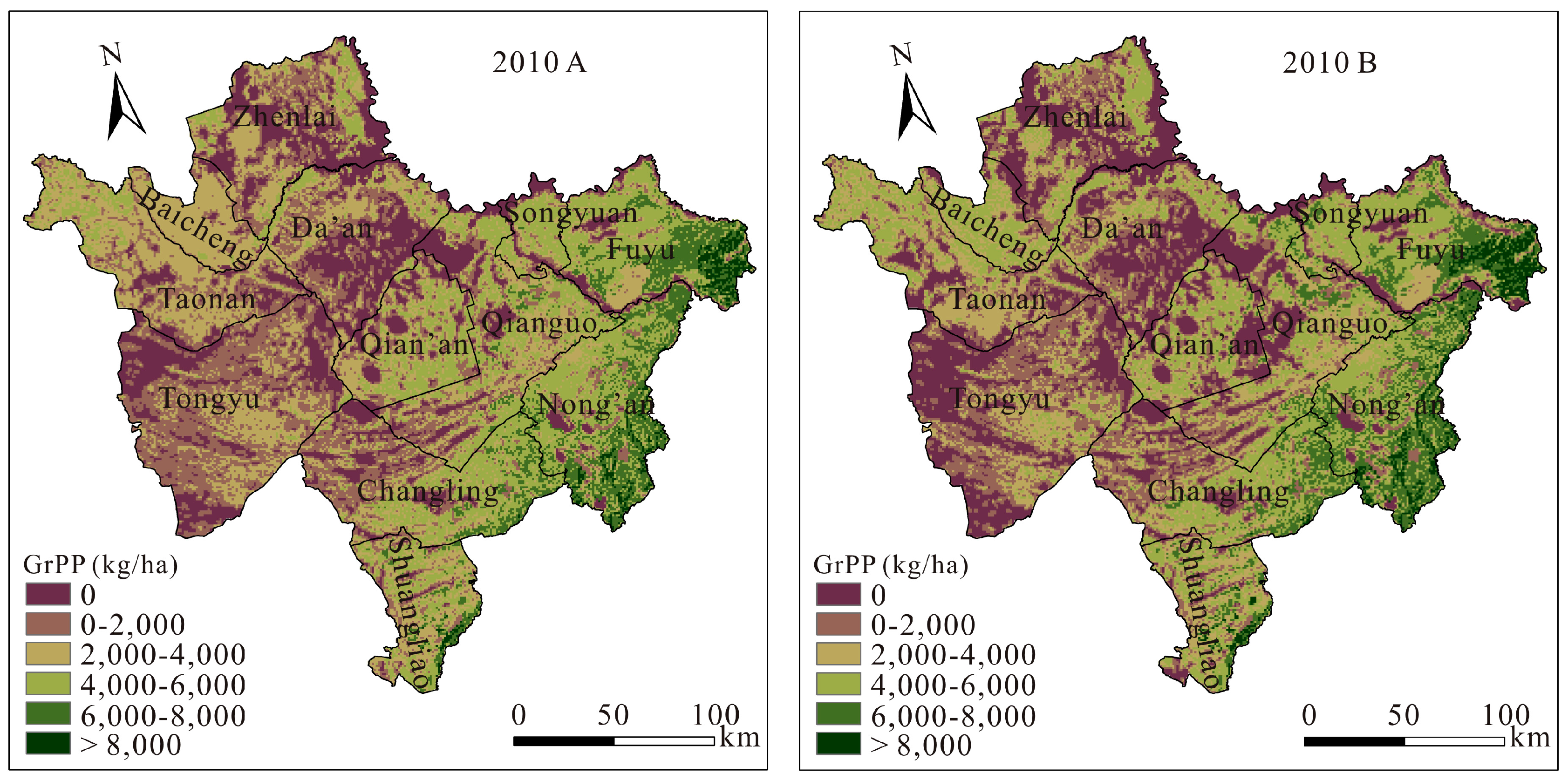
4.3. Limitations
5. Conclusions
Acknowledgments
Author Contributions
Conflicts of Interest
References
- Shi, S.; Chen, Y.; Yao, Y.; Zhibin, L.; Yingbin, H. Impact assessment of cultivated land change upon grain productive capacity in Northeast China. Acta Geogr. Sin. 2008, 63, 574–586. [Google Scholar]
- Liu, L.; Xu, X.; Liu, J.; Chen, X.; Ning, J. Impact of farmland changes on production potential in China during 1990–2010. J. Geogr. Sci. 2015, 25, 19–34. [Google Scholar] [CrossRef]
- Fu, Z.; Cai, Y.; Yang, Y.; Dai, E. Research on the relationship of cultivated land change and food security in China. J. Nat. Resour. 2001, 16, 313–319. [Google Scholar]
- Turner, B.L., II; Skole, D.L.; Sanderson, S.; Fischer, G.; Fresco, L.; Leemans, R. Land-use and land-cover change: Science/research plan. Glob. Chang. Rep. 1995, 43, 669–679. [Google Scholar]
- Turner, B.L., II; Lambin, E.F.; Reenberg, A. The emergence of land change science for global environmental change and sustainability. Proc. Natl. Acad. Sci. USA 2007, 104, 20666–20671. [Google Scholar] [CrossRef] [PubMed]
- Lambin, E.F.; Turner, B.L.; Geist, H.J.; Agbola, S.B.; Angelsen, A.; Bruce, J.W.; Coomes, O.T.; Dirzo, R.; Fischer, G.; Folke, C.; et al. The causes of land-use and land-cover change: Moving beyond the myths. Glob. Environ. Chang. 2001, 11, 261–269. [Google Scholar] [CrossRef]
- Lambin, E.F.; Geist, H.J.; Lepers, E. Dynamics of land-use and land-cover change in tropical regions. Annu. Rev. Environ. Resour. 2003, 28, 205–241. [Google Scholar] [CrossRef]
- Rounsevell, M.D.A.; Arneth, A.; Brown, D.G. Incorporating Human Behavior and Decision Making Processes in Land Use and Climate System Models; GLP Report No. 7; GLP International Project Office: São José dos Campos, Brazil, 2013. [Google Scholar]
- GLP. Land Transformations: Between Global Challenges and Local Realities; Humboldt Universität: Berlin, Germany, 2014. [Google Scholar]
- Xu, X.; Liu, J.; Cao, M.; Zhang, S. Impact of Recent Climate Fluctuation and LUCC Process on Potential Productivity for Crops in Northeast China. Sci. Geogr. Sin. 2007, 27, 318–324. [Google Scholar]
- Pan, P.; Yang, G.; Weizhong, S.U. Progress on Effects of Land Use Change on Land Productivity. Prog. Geogr. 2012, 31, 539–550. [Google Scholar]
- Ittersum, M.K.V.; Leffelaar, P.A.; Keulen, H.V. On approaches and applications of the Wageningen crop models. Eur. J. Agron. 2003, 18, 201–234. [Google Scholar] [CrossRef]
- Jones, P.G.; Thornton, P.K. The potential impacts of climate change on maize production in Africa and Latin America in 2055. Glob. Environ. Chang. 2003, 13, 51–59. [Google Scholar] [CrossRef]
- Yun, J.I. Predicting regional rice production in South Korea using spatial data and crop-growth modeling. Agric. Syst. 2003, 77, 23–38. [Google Scholar] [CrossRef]
- Easterling, W.E.; Weiss, A.; Hays, C.J.; Mearns, L.O. Spatial scales of climate information for simulating wheat and maize productivity: The case of the US Great Plains. Agric. For. Meteorol. 2003, 90, 51–63. [Google Scholar] [CrossRef]
- Priya, S.; Shibasaki, R. National spatial crop yield simulation using GIS-based crop production model. Ecol. Model. 2001, 135, 113–129. [Google Scholar] [CrossRef]
- Basso, B.; Ritchie, J.T.; Pierce, F.J.; Braga, R.P.; Jones, J.W. Spatial validation of crop models for precision agriculture. Agric. Syst. 2001, 68, 97–112. [Google Scholar] [CrossRef]
- Batchelor, W.D.; Basso, B.; Paz, J.O. Examples of strategies to analyze spatial and temporal yield variability using crop models. Eur. J. Agron. 2002, 18, 141–158. [Google Scholar] [CrossRef]
- Fischer, G.; Velthuizen, H.V.; Shah, M.; Nachtergaele, F. Global agro-ecological assessment for agriculture in the 21st century. J. Henan Vocat.-Tech. Teacher’s Coll. 2002, 11, 371–374. [Google Scholar]
- Fischer, G.; Shah, M.; Tubiello, F.N.; Velthuizen, H.V. Socio-economic and climate change impacts on agriculture: An integrated assessment, 1990–2080. Philos. Trans. R. Soc. B 2005, 360, 2067–2083. [Google Scholar] [CrossRef] [PubMed]
- Fischer, G.; Shah, M.; Velthuizen, H.V.; Nachtergaele, F. Agro-ecological zones assessments. Land Use Land Cover Soil Sci. 2006, 3, 1–9. [Google Scholar]
- Fischer, G.; Tubiello, F.N.; Velthuizen, H.V.; Wiberg, D. Climate change impacts on irrigation water requirements: Effects of mitigation, 1990–2080. Technol. Forecast. Soc. Chang. 2007, 74, 1083–1107. [Google Scholar] [CrossRef]
- Fischer, G.; Velthuizen, H.V.; Hizsnyik, E.; Wiberg, D. Potentially obtainable yields in the semi-arid tropics. In Global Theme on Agroecosystems Report No. 54; ICRISAT: Andhra Pradesh, India, 2009. [Google Scholar]
- Fischer, G.; Sun, L.X. Model based analysis of future land-use development in China. Agric. Ecosyst. Environ. 2001, 85, 163–176. [Google Scholar] [CrossRef]
- International Institute for Applied Systems Analysis (IIASA). Global Agro-Ecological Zones. Available online: http://www.gaez.iiasa.ac.at/ (accessed on 22 October 2015).
- Fischer, G.; Teixeira, E.; Hizsnyik, E.T. Land use dynamics and sugarcane production. In Sugarcane Ethanol: Contribution to Climate Change Mitigation and the Environment; Wageningen Academic: Wageningen, The Netherland, 2008; pp. 29–62. [Google Scholar]
- Teixeira, E.I.; Fischer, G.; Velthuizen, H.V.; Walter, C.; Ewert, F. Global hot-spots of heat stress on agricultural crops due to climate change. Agric. For. Meteorol. 2013, 170, 206–215. [Google Scholar] [CrossRef]
- Deng, X.; Huang, J.; Rozelle, S.D.; Uchida, E. Cultivated land conversion and potential agricultural productivity in China. Land Use Policy 2006, 23, 372–384. [Google Scholar] [CrossRef]
- Shortridge, A.; Messina, J. Spatial structure and landscape associations of SRTM error. Remote Sens. Environ. 2011, 115, 1576–1587. [Google Scholar] [CrossRef]
- Hutchinson, M.F. Interpolating mean rainfall using thin plate smoothing splines. Int. J. Geogr. Inf. Syst. 1995, 9, 385–403. [Google Scholar] [CrossRef]
- Hutchinson, M.F. Interpolation of rainfall data with thin plate smoothing splines. Part I: Two dimensional smoothing of data with short range correlation. J. Geogr. Inf. Decis. Anal. 1998, 2, 139–151. [Google Scholar]
- Hutchinson, M.F. Interpolation of rainfall data with thin plate smoothing splines. Part II: Analysis of topographic dependence. J. Geogr. Inf. Decis. Anal. 1998, 2, 152–167. [Google Scholar]
- Tatsumi, K.; Yamashiki, Y.; Valmir da Silva, R.; Takara, K.; Matsuoka, Y.; Takahashi, K.; Maruyama, K.; Kawahara, N. Estimation of potential changes in cereals production under climate change scenarios. Hydrol. Process. 2011, 25, 2715–2725. [Google Scholar] [CrossRef]
- Li, F.; Zhang, S.; Bu, K.; Yang, J.; Wang, Q.; Chang, L. The relationships between land use change and demographic dynamics in Western Jilin province. J. Geogr. Sci. 2015, 25, 617–636. [Google Scholar] [CrossRef]
- Chen, S.; Lu, W.; Luo, J. Multifractal characteristic of meteorological drought in western of Jilin province. J. Jilin Univ. 2013, 43, 245–250. [Google Scholar]
- Shen, X.; Wu, Z.; Du, H. Characteristics of climatic change in semiarid region of Western Jilin in recent 50a. J. Arid Land Resour. Environ. 2014, 28, 190–196. [Google Scholar]
- Alix-Garcia, J.; Bartlett, A.; Saah, D. The landscape of conflict: IDPs, aid and land-use change in Darfur. J. Econ. Geogr. 2013, 13, 589–617. [Google Scholar] [CrossRef]
- Gingrich, S.; Niedertscheider, M.; Kastner, T.; Haberl, H.; Cosor, G.; Krausmann, F.; Kuemmerle, T.; Müller, D.; Reith-Musel, A.; Jepsen, M.R.; et al. Exploring long-term trends in land use change and aboveground human appropriation of net primary production in nine European countries. Land Use Policy 2015, 47, 426–438. [Google Scholar] [CrossRef]
- Wang, Y.; Li, Y. Land exploitation resulting in soil salinization in a desert-oasis ecotone. Catena 2013, 100, 50–56. [Google Scholar] [CrossRef]
- Tanner, C.C.; Howard-Williams, C.; Tomer, M.D.; Lowrance, R. Bringing together science and policy to protect and enhance marsh ecosystem services in agricultural landscapes. Ecol. Eng. 2013, 56, 1–4. [Google Scholar] [CrossRef]
- Szöcs, E.; Coring, E.; Bäthe, J.; Schäfer, R.B. Effects of anthropogenic salinization on biological traits and community composition of stream macroinvertebrates. Sci. Total Environ. 2014, 468–469, 943–949. [Google Scholar] [CrossRef] [PubMed]
- Garrett, R.D.; Lambin, E.F.; Rosamond, L.N. The new economic geography of land use change: Supply chain configurations and land use in the Brazilian Amazon. Land Use Policy 2013, 34, 265–275. [Google Scholar] [CrossRef]
- Li, Z.; Liu, X.; Ma, T. Retrieval of the surface evapotranspiration patterns in the alpine grassland-marsh ecosystem applying SEBAL model in the source region of the Yellow River, China. Ecol. Model. 2013, 270, 64–75. [Google Scholar] [CrossRef]
- Tan, B.; Masek, J.G.; Wolfe, R.; Gao, F.; Huang, C. Improved forest change detection with terrain illumination corrected Landsat images. Remote Sens. Environ. 2013, 136, 469–483. [Google Scholar] [CrossRef]
- Liu, W.; Zhu, J.; Jia, Q.; Zheng, X.; Li, J.; Lou, X.; Hu, L. Carbon sequestration effects of shrublands in Three-North Shelterbelt Forest region, China. Chin. Geogr. Sci. 2014, 24, 444–453. [Google Scholar] [CrossRef]
- Wang, Q.; Zhang, B.; Zhang, Z.; Zhang, X.; Dai, S. The Three-North Shelterbelt Program and dynamic changes in vegetation cover. J. Resour. Ecol. 2014, 5, 53–59. [Google Scholar] [CrossRef]
- Wei, Y.; Xiu, C.; Sun, P. Dynamic mechanism of urbanization in China since 2000. Geogr. Res. 2013, 32, 1679–1687. [Google Scholar]
- Camagni, R.; Gibelli, M.C.; Rigamonti, P. Urban mobility and urban form: The social and environmental costs of different patterns of urban expansion. Ecol. Econ. 2002, 40, 199–216. [Google Scholar] [CrossRef]
- Lerner, A.; Sweeney, S.; Eakin, H. Growing buildings in corn fields: Urban expansion and the persistence of maize in the Toluca Metropolitan Area, Mexico. Urban Stud. 2013, 51, 2185–2201. [Google Scholar] [CrossRef]
- Batisani, N.; Yarnal, B. Urban expansion in Centre County, Pennsylvania: Spatial dynamics and landscape transformations. Appl. Geogr. 2009, 29, 235–249. [Google Scholar] [CrossRef]
- Du, F. Impacts of replacing agriculture with forestation policy on agricultural production in Zhuozi County. J. Arid Land Resour. Environ. 2008, 22, 86–90. [Google Scholar]
- Zhao, B.; Kreuter, U.; Li, B.; Ma, Z.; Chen, J.; Nakagoshi, N. An ecosystem service value assessment of land-use change on Chongming Island, China. Land Use Policy 2004, 21, 139–148. [Google Scholar] [CrossRef]
- Schröter, D.; Cramer, W.; Leemans, R.; Prentice, I.C.; Araújo, M.B.L.; Arnell, N.W.; Bondeau, A.; Bugmann, H.; Carter, T.R.; Gracia, C.A.; et al. Ecosystem service supply and vulnerability to global change in Europe. Science 2005, 310, 1333–1337. [Google Scholar] [CrossRef] [PubMed]
- Nelson, E.; Sander, H.; Hawthorne, P.; Conte, M.; Ennaanay, D.; Wolny, S.; Manson, S.; Polasky, S. Projecting global land-use change and its effect on ecosystem service provision and biodiversity with simple models. PLoS ONE 2010. [Google Scholar] [CrossRef]
- Mendoza-González, G.; Martínez, M.L.; Lithgow, D.; Pérez-Maqueoc, O.; Simonind, P. Land use change and its effects on the value of ecosystem services along the coast of the Gulf of Mexico. Ecol. Econ. 2012, 82, 23–32. [Google Scholar] [CrossRef]
- Carreño, L.; Frank, F.C.; Viglizzo, E.F. Tradeoffs between economic and ecosystem services in Argentina during 50 years of land-use change. Agric. Ecosyst. Environ. 2012, 154, 68–77. [Google Scholar] [CrossRef]
© 2015 by the authors; licensee MDPI, Basel, Switzerland. This article is an open access article distributed under the terms and conditions of the Creative Commons Attribution license (http://creativecommons.org/licenses/by/4.0/).
Share and Cite
Li, F.; Zhang, S.; Xu, X.; Yang, J.; Wang, Q.; Bu, K.; Chang, L. The Response of Grain Potential Productivity to Land Use Change: A Case Study in Western Jilin, China. Sustainability 2015, 7, 14729-14744. https://doi.org/10.3390/su71114729
Li F, Zhang S, Xu X, Yang J, Wang Q, Bu K, Chang L. The Response of Grain Potential Productivity to Land Use Change: A Case Study in Western Jilin, China. Sustainability. 2015; 7(11):14729-14744. https://doi.org/10.3390/su71114729
Chicago/Turabian StyleLi, Fei, Shuwen Zhang, Xinliang Xu, Jiuchun Yang, Qing Wang, Kun Bu, and Liping Chang. 2015. "The Response of Grain Potential Productivity to Land Use Change: A Case Study in Western Jilin, China" Sustainability 7, no. 11: 14729-14744. https://doi.org/10.3390/su71114729
APA StyleLi, F., Zhang, S., Xu, X., Yang, J., Wang, Q., Bu, K., & Chang, L. (2015). The Response of Grain Potential Productivity to Land Use Change: A Case Study in Western Jilin, China. Sustainability, 7(11), 14729-14744. https://doi.org/10.3390/su71114729





